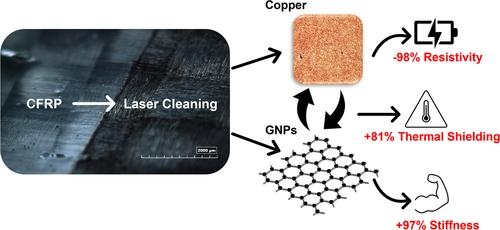Copper-graphene coatings for improving thermal shielding of CFRPs through electrodeposition techniques
IF 4.7
2区 材料科学
Q2 MATERIALS SCIENCE, COMPOSITES
引用次数: 0
Abstract
Today, carbon fiber reinforced plastics (CFRPs) are materials of interest several industrial sectors because of their mechanical properties and low weight. However, applications in high-temperature areas are limited because of thermal degradation. Thus, thin coatings acting as thermal shielding and ensuring the upkeep of CFRP structural stiffness are of high interest. This work presents an innovative approach to produce copper/graphene bilayer coatings through electrodeposition and electrophoretic deposition; it consists of laser pre-treatment of the composite surface to remove the matrix layer exposing the carbon fibers, enabling the subsequent deposition. Bi-layer graphene/copper coatings exhibit an enhancement in copper electrodeposition efficiency of more than 59% resulting in a 97% stiffness improvement compared to the single layer copper electroplating. All the obtained coatings were able to act as a thermal shield of the CFRPs, reducing the maximum temperature of the composite by more than 60%. In particular, due to the synergistic effect of copper and graphene, the GNPs-Cu coating achieved the highest maximum temperature reduction (81%). Cross-sectional analysis indicates severe delamination in uncoated CFRPs, whereas double-layer coatings maintain structural integrity and prevent delamination even under high-energy exposure. In addition, the coated composites exhibit a higher electrical conductivity compared to the laser cleaned CFRP, with the GNPs-Cu coating that obtained a 90% enhancement because of the outstanding electrical properties of copper and graphene.

通过电沉积技术改善 CFRP 热屏蔽的铜石墨烯涂层
如今,碳纤维增强塑料(CFRP)因其机械性能好、重量轻而成为多个工业部门感兴趣的材料。然而,由于热降解的原因,其在高温领域的应用受到了限制。因此,作为热屏蔽并确保 CFRP 结构刚度的薄涂层备受关注。本研究提出了一种通过电沉积和电泳沉积生产铜/石墨烯双层涂层的创新方法;该方法包括对复合材料表面进行激光预处理,以去除基体层,使碳纤维暴露出来,从而实现后续沉积。与单层电镀铜相比,双层石墨烯/铜涂层的铜电沉积效率提高了 59% 以上,从而使硬度提高了 97%。所有获得的涂层都能作为 CFRP 的热屏蔽,将复合材料的最高温度降低 60% 以上。特别是,由于铜和石墨烯的协同作用,GNPs-铜涂层的最高温度降低率(81%)最高。横截面分析表明,未涂层的 CFRP 存在严重的分层现象,而双层涂层即使在高能量暴露的情况下也能保持结构的完整性并防止分层。此外,与激光清洁过的 CFRP 相比,涂层复合材料具有更高的导电性,其中 GNPs-Cu 涂层的导电性提高了 90%,这是因为铜和石墨烯具有出色的导电性能。
本文章由计算机程序翻译,如有差异,请以英文原文为准。
求助全文
约1分钟内获得全文
求助全文
来源期刊

Polymer Composites
工程技术-材料科学:复合
CiteScore
7.50
自引率
32.70%
发文量
673
审稿时长
3.1 months
期刊介绍:
Polymer Composites is the engineering and scientific journal serving the fields of reinforced plastics and polymer composites including research, production, processing, and applications. PC brings you the details of developments in this rapidly expanding area of technology long before they are commercial realities.
 求助内容:
求助内容: 应助结果提醒方式:
应助结果提醒方式:


